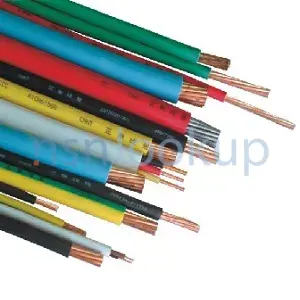Radio Frequency Cable
Item Name Code (INC) 00779
 |
An item consisting of electrical conductors separated from each other by a continuous homogeneous dielectric (including porous types and touching and/or interlocking beads or spacers), and designed primarily for the conduction of radio frequency energy. Includes a single conductor inclosed in an outer concentric conductor (coaxial) with or without a protective sheath; two or more coaxial cables laid parallel with an outer electrical shield and/or common sheath; two or more parallel conductors with an outer electrical shield and/or a common sheath; two or more individually insulated twisted conductors with or without an electrical shield and/or protective covering. All types have low-loss or special characteristics at high frequencies. Refers to bulk quantities only; for items of definite length with processed ends or terminated in fittings, see CABLE ASSEMBLY, RADIO FREQUENCY. See also LINE, RADIO FREQUENCY TRANSMISSION.
 Additional Information for Radio Frequency Cable
Additional Information for Radio Frequency Cable
Radio Frequency (RF) cables are a type of cable used for transmitting high-frequency signals, typically in the range of 3 kilohertz (kHz) to 300 gigahertz (GHz). These cables are designed to minimize signal loss and interference, making them suitable for applications that require high-quality signal transmission, such as telecommunications, broadcasting, and wireless communication systems.
RF cables are commonly used to connect various electronic devices, such as antennas, transmitters, receivers, and amplifiers. They are typically made of a conductor, an insulating material, and an outer shielding layer. The conductor is usually made of copper or aluminum, while the insulating material is typically made of materials like polyethylene or polypropylene. The outer shielding layer is made of materials like aluminum foil or braided copper to protect the signal from external interference.
RF cables come in various types, including coaxial cables, triaxial cables, and waveguide cables. Coaxial cables are the most common type and consist of a central conductor surrounded by an insulating layer, a metallic shield, and an outer insulating layer. Triaxial cables have an additional layer of shielding for improved signal quality and reduced interference. Waveguide cables, on the other hand, use a hollow metal tube to guide the signal.
When selecting an RF cable, it is important to consider factors such as the frequency range, impedance, power handling capacity, and environmental conditions. Different applications may require different types of RF cables to ensure optimal signal transmission and performance.
In summary, RF cables are specialized cables used for transmitting high-frequency signals in various electronic applications. They are designed to minimize signal loss and interference, making them essential for reliable and high-quality signal transmission in telecommunications, broadcasting, and wireless communication systems.